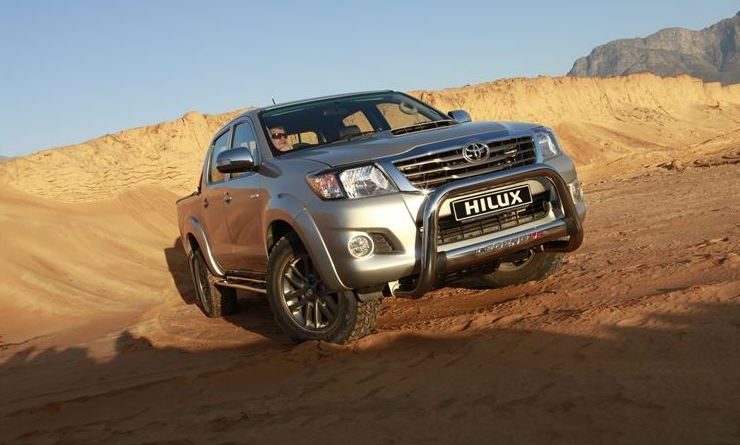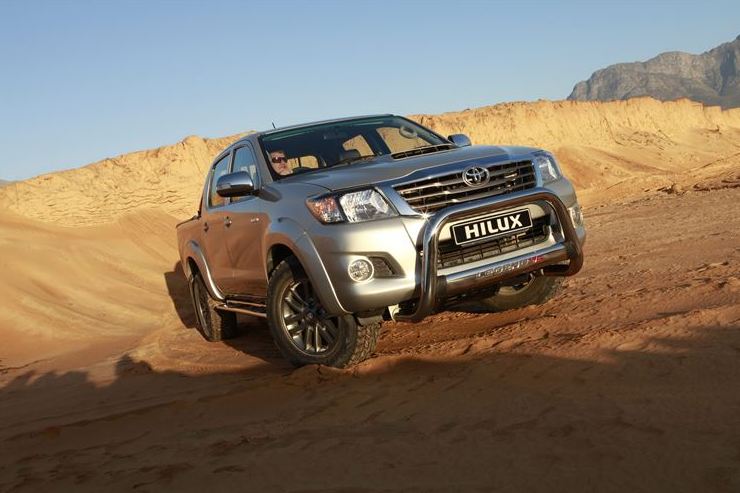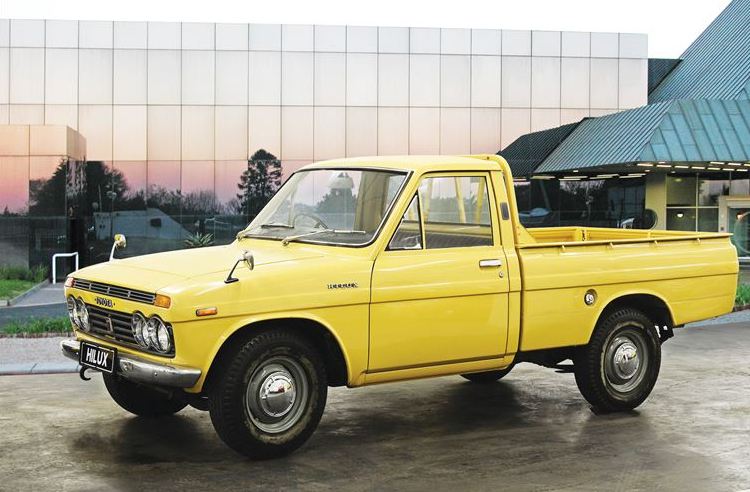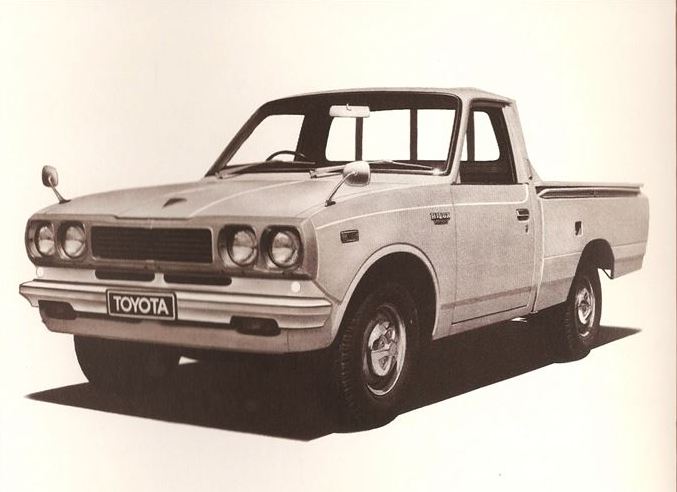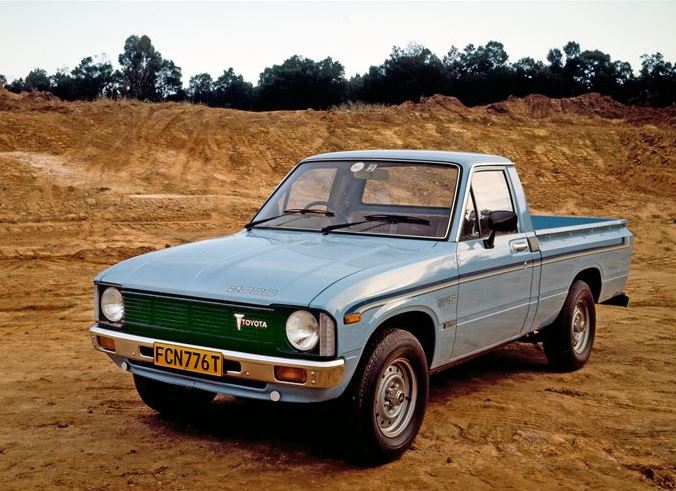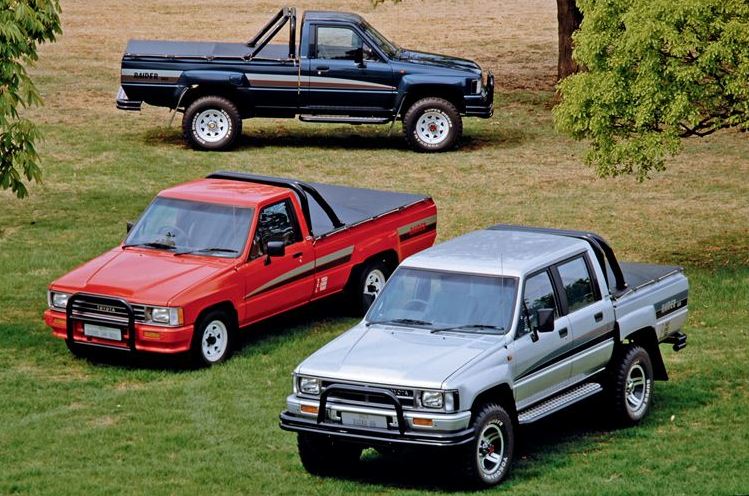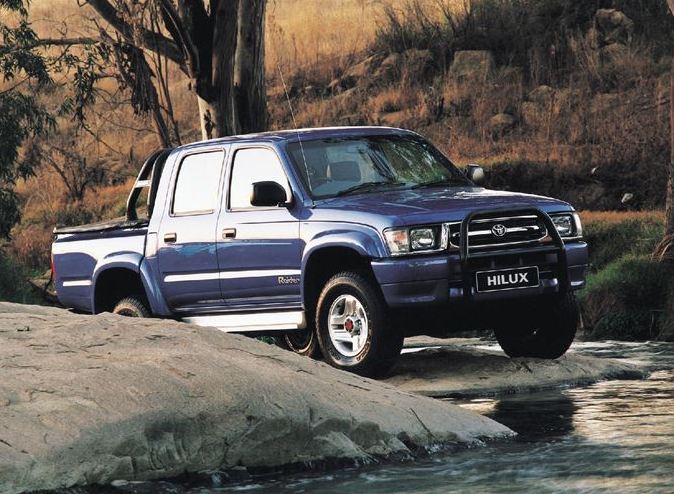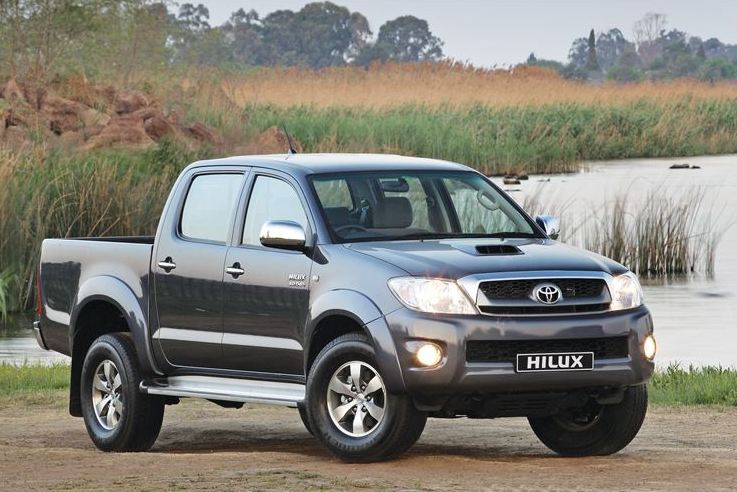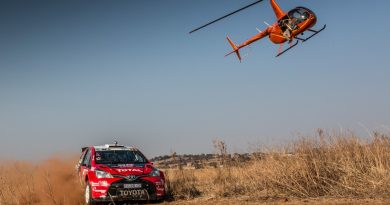Toyota Hilux -The Legend Returns!
- New Hilux Legend 45 package for top-end Raider models
- 13 different variants
For over 45 years, 13 million Toyota Hilux pick-ups have been forging trails around the globe from the Arctic tundra to the deserts of the Kalahari. This unstoppable vehicle has earned the highest trust and admiration for its off-road capabilities, endurance and overall ability.
Who can forget Clarkson and Co of BBC Top Gear fame taking an elderly 1988 diesel Hilux with over 305 000 km on the clock and subjecting it to all sorts of physical abuse. The mechanical torture consisted of driving it down a flight of steps, scraping buildings, crashing headlong into a tree, being washed out to sea, submerging it in the swirling water for four hours, driving it through a garden shed, dropping a caravan onto it, clobbering it with a wrecking ball, setting it on fire and, finally, placing it on top of a multi-story apartment block before unceremoniously setting off a controlled explosion which imploded the entire building. All that remained was a pile of rubble and – yes you guessed it – that Hilux. Nevertheless it was dug out of the heap and resuscitated with nothing more than a few tools that were left in the truck’s toolbox. As testament to the Hilux’s never-say-die attitude it now enjoys pride of place in the Top Gear studios and was appropriately dubbed ‘The Invincible Hilux’.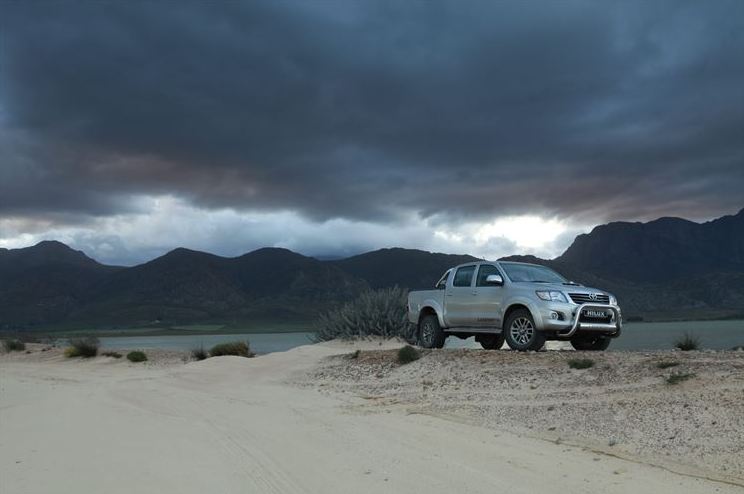
In the words of Glenn Crompton, Vice President of Marketing for Toyota SA Motors: “Hilux is the Corolla of the light commercial world and its worldwide success is by no means accidental. Evolutionary progress through the generations has produced a vehicle with the ideal combination of superlative off-road driving manners, car-like refinement, plus rugged workhorse credentials. More than perhaps any other Hilux generation, this seventh iteration has seen numerous, successive improvements throughout its life, each of which has enabled the model to consistently exceed consumer needs and assure its place right at the top of the sales charts. It’s undoubtedly the purest distillation of toughness and versatility you’ll ever find in pick-up and, best of all, it’s rooted in the guiding principles of Toyota’s QDR (Quality, Durability and Reliability).”
And now, to celebrate 45 years of ‘bundu bashing’ excellence, Toyota South Africa is pleased to announce the introduction of the aptly named Legend 45. Applied to 100 percent of all Raider (high spec) production, this value-for-money, special edition 45 package is available in 4×2 Raised Body and 4×4 formats and across all variants – Single Cab, Xtra Cab and Double Cab. In total there are 13 different Legend 45 model variants.
Distinguishing it from the rest of the Hilux range, the Legend 45 gets the following exterior treatment:
- New headlamp and front fog lamp design with black-out detail
- Smoked tail light design
- Stainless steel front nudge bar
- Stainless steel rear step bumper
- Towbar
- Matt black side steps
- Exclusive Legend 45 badging for the nudge bar, side decals and tailgate
- Colour-coded door handles with chrome finish mirrors
- Multi-spoke 17-inch anthracite alloy wheels
- Full range of exterior colours including Glacier White, Chromium Silver, Chilli Red, Pacific Blue Metallic, Graphite Grey, Attitude Black, Silky Gold and Dark Steel Mica
- Tonneau cover and rear styling bar available as a cost option (Legend 45 Plus)
Likewise when it comes to the interior, Legend 45 models are tastefully and liberally specced:
- Full black interior for the cabin including dashboard finish
- Black leather with silver contrast stitching on the seats, door panels, steering wheel and shift lever boot (manual)
- Reverse camera now added to Xtra Cab Legend 45 models as well as 2.5 D-4D and 2.7 VVTi Legend 45 models (standard on all other Double Cab Legend 45 models)
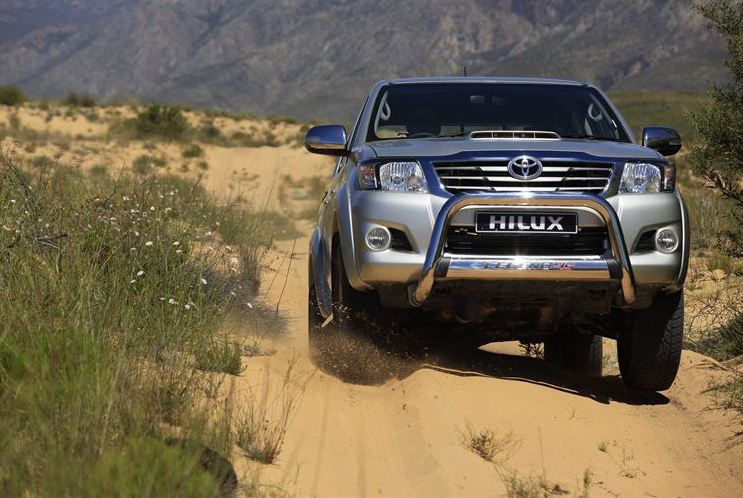
It’s worth noting that in terms of kit, the Hilux is one of the most generously equipped pick-ups on the market with all 3.0 D-4D and 4.0 V6 Double Cab models coming standard with a full suite of luxury and safety accoutrements ranging from automatic climate control, auto lights, multi-function steering wheel and display audio (with reverse camera) to six airbags and stability control. (For a full list of equipment please see the spec sheet.)
The Legend 45’s purposeful appearance is matched by the power that drives it. This special anniversary model is available with choice of tried and tested Toyota powerplants, transmissions and drive types:
Legend 45 Single Cab
- 2.7 VVTi 4×2 Raised Body – R300 200
- 3.0 D-4D 4×2 RB – R345 100
- 3.0 D-4D 4×4 – R401 200
Legend 45 Xtra Cab
- 3.0 D-4D 4×2 RB – R374 100
- 3.0 D-4D 4×4 – R430 400
Legend 45 Double Cab
- 2.5 D-4D 4×2 RB – R411 900
- 2.7 VVTi 4×2 RB – R377 900
- 3.0 D-4D 4×2 RB – R438 300
- 3.0 D-4D 4×2 RB auto – R452 000
- 3.0 D-4D 4×4 – R495 500
- 3.0 D-4D 4×4 auto – R509 300
- 4.0 V6 4×2 RB auto – R451 200
- 4.0V6 4×4 auto – R533 900
Engine highlights
2.5 D-4D: This 106 kW diesel engine features variable nozzle turbo (VNT) technology. The turbine blade is infinitely adjustable, allowing for the blade angles to be optimised depending on engine load. The turbo is activated at very low rpm due to the fact that the blades are powered by an electric motor. Torque of 343 Nm is the same as for the 3.0-litre unit but comes in between 1 600 rpm and 2 800 rpm.
2,7 VVTi: Twin balancer shafts ensure smooth operation of this four-cylinder 16-valve petrol powerplant. It produces 118 kW at 5 200 rpm and maximum torque of 241 Nm at 3 800 rpm.
3.0 D-4D: Fuel delivery is controlled by an EDU (Electronic Driving Unit) that activates each injector at precisely the right time to inject a measured high pressure fuel charge drawn from the common fuel rail directly into each cylinder. This 3.0-litre four-cylinder turbocharged and inter-cooled engine with a 16-valve DOHC configuration delivers 120 kW of maximum power at 3 400 rpm. Peak torque of 343 Nm is delivered between 1 400 rpm and 3 200 rpm.
4.0 litre V6: Featuring a 24-valve DOHC configuration, this engine has a compact and lightweight design and makes use of an aluminium cylinder block. It produces 175 kW at 5 200 rpm and has a torque rating of 376 Nm at 3 800 rpm.
Toyota Hilux Family Tree
Tracing the genealogy of the world’s favourite pick-up
1st Generation
Model Code: N10 (1969 – 1972)
Engine: 1.5 four-cylinder petrol
Body: Single Cab
Launched during the last quarter of 1969, the Hilux immediately made its mark and 386 units were sold for a sticker price of just R1 525. SA bakkie buyers embraced the Hilux and it became market segment leader in 1970 when 7 380 units were sold. The long wheelbase version was introduced in 1972.
2nd Generation
Model Code: N20 (1973 – 1978)
Engines: 1.6 & 2.0 4-cylinder petrol
Body: Single Cab
Essentially a reworked version of its predecessor, the N20 series featured an updated body with slightly extended wheelbases and more comfortable interior. The SA model range was expanded to four models with two petrol engine options – the 1.6-litre and 2.0-litre. Nearly 13 500 units were sold in 1975.
3rd Generation
Model Code: N30 (1979 – 1983)
Engines: 1.6 & 2.0 4-cylinder petrol / 2.2 diesel
Body: Single Cab
Versatility was the watchword for the third-generation N30 series Hilux that went on sale in 1979. Irrespective of model – there were now three standard-length and four long-wheelbase derivatives – it was designed to offer saloon-like specification and ride comfort, which led to an evolution of the predecessor’s double wishbone front suspension which saw the coil springs replaced with a torsion bar. Front disc brakes were included for the first time. In addition to diesel, this 3rd Generation also ushered in the first 4×4 variant.
4th Generation
Model Code: N40 (1984 – 1989)
Engines: 2.0 & 2.2 petrol / 2.2 diesel
Body: Single & Double Cab
Immediately distinguishable from its older sibling through attractively blistered wheel arches and a renewed interior, the N40 was available in Single- as well as Double-cab versions. In November 1997, the Hilux broke through the 500 000th units sold barrier.
5th Generation
Model Code: N50 (1989 – 1998)
Not available in SA
6th Generation
Model Code: N60 (1998 – 2005)
Engines: 2.7 petrol & 3.0 diesel
Body: Single & Double Cab
Easily identified, the 6th Generation was characterised by a swage line that gently tapers downwards toward the front indicators. Toyota gently refocused this Hilux into two clear branches – business use and personal use. Personal-use models were now borderline sporty, coming with additional equipment and devices to better suit their recreational intentions, such as a longer and taller cabin with improved sound insulation. Business-use models, on the other hand, were more basic in their approach and offered lower specification levels. Independent front suspension for 4×4 models, raised body configuration, front airbags and ABS brakes were just some of the stand-out features.
7th Generation
Model Code: N70 (2005 to present / major facelift in 2011)
Engines: 2.0, 2.7 & 4.) petrol / 2.5 & 3.0 diesel
Body: Single, Double & Xtra Cab
Based on a modified version of the ladder frame underpinnings found on the N60, the current seventh-generation N70 chassis Hilux has significantly grown in stature to become classified as a mid-size pick-up (the platform has also been adapted into an SUV for the Toyota Fortuner model). This change gifted the car with greater road presence, interior space, and load capacity – all improvements identified from customer reports. A comprehensive re-style and engine re-fettle was applied in 2011 as well as the addition of a new Xtra Cab model for the 2012 model year. Across the board changes encompassed smoother architecture from the A-pillar forwards. Inside, the dashboard was changed and now houses the latest version of the Toyota Touch multimedia system for all Raider/Legend 45 models.
45 Reasons why the Toyota Hilux is a Legend
- Its name is derived from the words “High” and “Luxury” – something it’s lived up to till this day.
- The world’s best-selling pick-up, Hilux passed the 13 million sales figure in 2013.
- As of 2014, the only countries in the world that do not sell the Hilux are Japan, United States, Canada, North Korea, and South Korea.
- Market leader in South Africa for 43 years.
- 969 933 units sold in South Africa as at September 2014.
- Currently holds an average 34% share of the South African 1 ton market (1994 to 2014).
- The longest active model range of any vehicle in South Africa.
- Proudly South African, Hilux is built at the Prospecton Plant in Durban. Local content is 50%.
- Six generations of Hilux models have been built at the Prospecton Plant.
- 156 302 Hilux units built at the Prospecton plant in 2013.
- Toyota SA exported 72 877 Hilux units to 67 countries in 2013.
- Hilux currently offers the widest range of models to choose from – 21 in total.
- First to offer a long-wheelbase in 1972 (2nd Generation).
- In 1979 Toyota was the first manufacturer to offer a 4×4 variant (3rd Generation).
- The inclusion of a 2,2-litre diesel engine in the model line-up in 1979 was another first for Toyota in this market sector.
- First to offer a double cab variant in 1984 (4th Generation).
- In 1986 Toyota became the first manufacturer to offer a five-speed transmission on its one-ton pick-ups.
- In 1989 this range was further expanded when the first diesel 4×4 one-tonner offered in SA was added to the Hilux line-up.
- First to market with ABS brakes in 1998 (5th Generation).
- First light commercial vehicle to offer dual front airbags – also in 1998.
- Raider became a household name and established a new benchmark for full-house spec on a bakkie. Never before had a top-end sound system, electric windows, air conditioning as well as the aforementioned safety kit been offered on a pick-up.
- The 5th Generation also saw the introduction of the new 5L 3-litre diesel engine with extended service intervals. This would be the first time buyers in this segment were offered this size of diesel engine with 10 000 km service intervals.
- Made motoring history in 2003 by setting the first-ever speed and endurance records for light commercial vehicles. Eight Hilux bakkies set 89 records in 72 hours at the Gerotek facility near Pretoria.
- Fire, water, dropped caravans and an implosion all fail to stop the indestructable Hilux in a BBC Top Gear episode screened in 2003. Immortalised in the Top Gear Studios and dubbed ‘The Invincible Hilux’.
- The Legend name was first adopted in 2003 to celebrate 35 years of market presence. This special edition was called the Legend 35 and became an instant success helping Hilux achieve 32% market share in that year despite the emergence of newer competitors.
- In 2004 the South African motoring media were treated to an adventure of a lifetime – the island of Madagascar was the backdrop to showcase the talents of the Hilux Legend 35. A total of 18 Hilux units traversed the stunning scenery of this island paradise.
- The 7th Generation Hilux debuted in 2005. Making this Hilux unique is that it’s based on Toyota’s IMV or International Multi-Purpose Vehicle platform which facilitates building four different models on essentially the same line. New Hilux therefore launched together with Fortuner which also became an instant hit. It was later joined by Xtra Cab and Innova.
- In the BBC Top Gear series of 2006, a Hilux was again chosen by Clarkson as his platform for creating an amphibious vehicle, redubbed the “Toybota”. It was driven by Clarkson over several miles by road and 3.2 km across open water, before capsizing (three metres away from the finish) during an over-ambitious turn.
- Then in 2007, Top Gear ran a special programme in which Clarkson and James May raced a customised 2005 model Hilux to the 1996 magnetic north pole from Northern Canada against Richard Hammond using a dog sled, and won. This episode, known as the Top Gear Polar Special, made the truck the first motor vehicle to make it to the magnetic north pole.
- Top Gear host James May drove a modified Hilux, one which had served as the camera crew’s vehicle during the 2007 polar special, to approach the summit of an erupting Icelandic volcano (Eyjafjallajökull) and retrieved a fragment of volcanic lava. The Hilux was modified for this task by the installation of a simple metal “umbrella” and alcohol cooling drips for its tyres.
- 2009 – Buddy makes his Hilux debut. In this memorable TV commercial Buddy abandons any attempts to behave with sophistication and grace. Instead, he has fun on the farm mocking the sheep he encounters and making bad jokes, whilst recognising the Hilux’s toughness.
- A partnership with Arctic Trucks (AT) in 2009 saw two AT Hilux vehicles, as part of an expedition organised by the Kazakhstan National Geographic Society (KNGS), cross 2 308 km of the Antarctica High Plateau from Novolazarevskaya station (Novo) to the South Pole in just 108 hours (4.5 days). This was the first time a conventional vehicle had ever traversed the South Pole.
- Then in 2011 two Hilux AT44 6×6 and two Hilux AT44 4×4 vehicles originally built in the Prospecton plant and thereafter converted to AT44 specification at TSAM’s Sandton workshops saw a team from Extreme World Races (EWR) set another new world record for the fastest time to reach the Pole. They followed a route from the ice edge near McMurdo Sound on the southern side of Antarctica, across the Ross Ice Shelf and on to the Antarctic plateau to reach their destination. Their journey started on 16 December and the Pole was reached on 18 December 2011 – only 47 hours (less than two days) later, of which only 17.5 hours was spent driving.
- Hilux established a Guinness World Record for assembling the largest number of Hilux 4×4 bakkies in one place. A total of 495 Hilux 4×4’s came together on Saturday 30 October 2010 in the Atlantis dunes north of Cape Town.
- 2010 also saw Toyota launch the Man-up Challenge, one of the most successful interactive marketing campaigns ever attempted by a motoring company. The gist of it was that participants had to prove how tough they were by collecting “Man” points in order to win a Hilux.
- Hilux spearheads Toyota’s Enviro Outreach Programme. In this annual scientific study programme which seeks to safeguard South Africa’s natural wealth and reduce biodiversity loss, one of the main aims is to tag fauna and flora in ecologically sensitive areas of Southern Africa. In 2012 a new species of beetle was discovered on the West Coast of South Africa and aptly named the ‘Toyoda’ Beetle. Hilux has been involved with the Enviro Outreach for six years.
- Giniel de Villiers becomes a household name thanks to Hilux and his success at the Dakar Rally. He places third in 2012, 2nd in 2013 and narrowly misses a podium finish by placing fourth in 2014. After his recent excellent performance at the Morocco Rally he’s confident that he’ll be back on the podium in 2015.
- Another motorsport milestone is the Toyota 1000 Kalahari Desert Race and yes, you guessed it, in 2014 Anthony Taylor piloting a Hilux was the victor. This was the 37th time that Toyota has sponsored this memorable race.
- Anthony Taylor is also on track to win the Cross Country Championships in a Hilux of course! This will be the third successive title for Toyota Hilux.
- A Toyota institution for the past 23 years, Rust de Winter is a firm favourite with off road aficionados. Hilux is, of course, the star of this rough terrain family event weekend.
- Another Hilux headliner is the annual Atlantis Desert 4×4 event in the Western Cape. Held every October for the past nine years this is one that’s given star status on the 4×4 calendar.
- Fostering new talent in farming circles, Toyota has sponsored the annual New Harvest and Young Farmer Agricultural awards for the past 11 years. This dual competition recognises excellence in the farming arena and has seen 22 young farmers become the recipients of brand new Toyota Hiluxes.
- Hilux has been instrumental in helping 70 young farmers find true love. Now into its seventh series, KykNet’s Boer Soek ‘n Vrou is synonymous with the ubiquitous Hilux.
- 13 October 2014 – the Legend 45 is welcomed into the Hilux fold. This is the third model in the Legend Series.
- 23 October 2014 – Hilux is an integral part of the Giant Flag Project, an initiative to publicise SA and to create sustainable development in the Graaff-Reinet area.

